|
Creating homeschool vocabulary worksheets can be a powerful tool for parents looking to enrich their children's education while nurturing a harmonious home environment. Here’s a guide to crafting effective, engaging worksheets that will make learning a joyful experience.
Why Vocabulary Worksheets Matter Vocabulary is the cornerstone of communication. Building a strong vocabulary helps children express themselves clearly, understand complex concepts, and excel academically. As homeschooling parents, we have the unique opportunity to tailor vocabulary lessons to our children's needs and interests. Step-by-Step Guide to Creating Homeschool Vocabulary Worksheets 1. Define Your Objectives Before you start, clarify what you want to achieve. Are you focusing on everyday language, academic vocabulary, or subject-specific terms? Knowing your goals will help you design targeted worksheets. 2. Choose the Right Words Select words that are age-appropriate and relevant to your child's current studies. For younger children, everyday words are ideal. For older students, include more challenging terms related to their subjects of study. 3. Incorporate Spiritual and Mindful Elements Infuse your worksheets with positive energy. Add inspirational quotes or affirmations related to the words being learned. For instance, if you're teaching the word "gratitude," include a brief mindfulness exercise that encourages children to reflect on what they are grateful for. 4. Use a Homeschool Worksheet Generator Utilize a homeschool worksheet generator to save time and ensure consistency. These tools can help you create customized worksheets that match your educational objectives. 5. Make it Interactive Interactive elements such as crossword puzzles, word searches, and matching exercises make learning fun and engaging. These activities also reinforce word recognition and retention. 6. Add Visual Aids Include pictures or symbols that represent the vocabulary words. Visual aids help children remember words better and make the worksheets more appealing. 7. Provide Context Give sentences or short paragraphs that use the vocabulary words in context. This helps children understand how words are used in everyday language. 8. Encourage Writing Practice Include sections where children can write sentences or short stories using the new vocabulary words. This practice reinforces their learning and encourages creativity. Magical Actions for Effective Learning
Examples of Effective Worksheets For Younger Children Objective: Learn five new animal-related words. Words: Lion, Elephant, Tiger, Giraffe, Monkey Activities:
For Older Students Objective: Learn ten new science-related words. Words: Atom, Molecule, Photosynthesis, Ecosystem, Gravity, Inertia, Velocity, Evolution, Gene, Organism Activities:
Manifest an Abundant School Year Creating effective vocabulary worksheets is just one way to ensure a successful homeschool experience. By incorporating spiritual and mindful elements, you can create a nurturing learning environment that fosters both academic and personal growth. Remember, the tools and resources you need are within reach, and your commitment to your child's education is a powerful force for good. Embrace this journey with confidence and love, and watch your child's vocabulary – and their spirit – flourish. Disclaimer: Crystal, spiritual, and healing interpretations are for informational purposes only. Your results may vary. Be safe and wise on your magical journey.
0 Comments
As a family that lives and breathes the homeschooling lifestyle, we understand the importance of being prepared. Whether it's a planned lesson or spontaneous educational moment, having the right tools can enhance the learning experience and make life easier. Here's a guide to the essential items that keep our family learning, engaged, and connected, no matter where we are. Embrace learning everywhere with these must-have items.
1. Stay Connected and Capture Moments with a Smartphone A high-quality smartphone is indispensable for modern homeschoolers. Use it to capture high-resolution photos and videos of your travels and lessons, which can serve as both educational material and cherished family memories. Additionally, a smartphone with internet access and GPS capabilities is crucial for navigation and safety. It ensures you can access educational resources on the go, stay on course during your travels, and handle any unexpected situations that might arise. 2. Library Card: Your Passport to Unlimited Knowledge Never underestimate the power of a library card. It’s your passport to a world of knowledge and an invaluable resource for homeschoolers. Whether you're near home or on the road, a library can be a treasure trove of learning materials relevant to your child's current interests or projects. Simplify access by attaching library cards to a convenient ID necklace or bracelet—this small step can save you a trip home and keep the learning flowing seamlessly. 3. Discover the Microscopic World with Collection Slides and Petri Dishes Our world is teeming with invisible wonders just waiting to be explored. Equip your young learners with collection slides and petri dishes for hands-on science experiments. From pond water samples teeming with microorganisms to fascinating plant cells, these tools allow children to bring the microscopic world into view with a microscope back at your home base. This practice not only enriches scientific understanding but also nurtures curiosity and a love for nature. 4. Stay Organized and Efficient with a Portable Solar Charger In the spirit of sustainable living and continuous learning, a portable solar charger is a must-have for any homeschooling family on the go. This eco-friendly device ensures that all your essential gadgets—smartphones, tablets, and cameras—are charged and ready to use, no matter how remote your educational adventures might take you. By harnessing the power of the sun, you can extend your learning sessions outdoors without the worry of running out of battery. 5. Stay Connected and Informed with a Compact Laptop or Tablet A compact laptop or tablet is an indispensable tool for homeschooling families on the move. Use it to access educational resources, stream documentaries, or follow up on a lesson with interactive content. Lightweight and portable, these devices ensure that your family has access to information and entertainment wherever you go, making them perfect for travel and field trips. Integrate Holistic and Shamanic Elements To deepen your family's connection to learning and the world around them, incorporate elements of shamanic spirituality and holistic practices:
Conclusion By equipping yourselves with these essential tools, your family can maximize the homeschooling experience and embrace learning in every environment. Remember, every moment is an opportunity to learn and grow together. As you continue on your educational journey, let these tools open up new horizons for your family. Disclaimer: Crystal, spiritual, and healing interpretations are for informational purposes only. Your results may vary. Be safe and wise on your magical journey. In a world where creativity meets spirituality, the art of crafting healing jewelry stands is filled with imagination and wellness. As a shamanic guide, homeschool mom, and advocate for holistic living, I'm here to guide you through teaching kids how to create their own pieces of healing jewelry. This activity is not just about crafting; it’s about instilling values of patience, mindfulness, and the healing properties of natural elements.
The Joy of Jewelry Making with Kids: Creative Healing Jewelry making is a delightful way for children to express their creativity while learning about the healing properties of different stones and crystals. It's an opportunity to bond, share stories about each stone’s significance, and nurture a deeper connection with the earth's gifts. Choosing the Right Stones and Crystals for Healing Begin by selecting stones and crystals with known healing properties. Amethyst for calmness, rose quartz for love, and turquoise for protection are great starts. Explain their meanings to the kids and let them feel and choose the ones they resonate with. Simple Techniques for Little Hands: Easy Jewelry Making Methods Opt for simple techniques suited for children. Elastic cord bracelets, beaded necklaces, and simple wire wrapping are great starting points. Ensure that the tools and materials are kid-friendly and safe. Incorporating Healing Intentions In Each Piece As you craft, discuss the importance of intentions. Encourage kids to think about what they want the jewelry to represent – perhaps a charm for courage at school or a peaceful amulet for bedtime. Safety First: Kid-Friendly Crafting Safety is paramount. Use non-toxic materials and age-appropriate tools. Supervise closely, especially when working with small beads or tools. Making It Fun and Educational By Combining Learning with Play Turn jewelry making into a fun learning experience. Introduce basic color theory, discuss the geological formation of crystals, or incorporate stories and traditional meanings related to the stones. Conclusion: Teaching kids to create healing jewelry is an enriching experience that combines art, spirituality, and education. It's a journey that not only results in beautiful pieces of jewelry but also imparts lessons of healing, creativity, and connection to nature. Start this magical journey today! Gather your materials, sit down with the little ones, and embark on a creative adventure that crafts more than just jewelry – it crafts lasting memories and valuable life lessons. Disclaimer: The healing properties of crystals and stones are for informational purposes only. Your results may vary. Always prioritize safety and supervision in crafting activities with children. Step into a world where the best learning toys weave heart, mind, body, and spirit together, blending core subjects and electives in perfect harmony. Our wholistic, affordable learning toy selections aren’t just tools; they’re keys to education, healing, and unschooling treasures. Whether you champion homeschool, free schooling, or simply wish to bolster your child's journey, missing out is like leaving money on the table. Seize control of their brilliant future now. 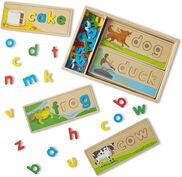 Experience the Magic of Words with Melissa & Doug's See & Spell. This wooden educational masterpiece melds mind and heart, offering 8 double-sided spelling boards and 64 letters. Perfect for holistic homeschooling, it unlocks the ancestral art of letters, shaping young minds for core subjects. Affordable and timeless, missing this gem is akin to bypassing a treasure trove of learning. Secure your child’s linguistic prowess today. 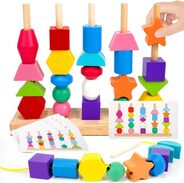 Crafted for kids aged 1 to 4, the wholistic ensemble in this Montessori Wooden Beads Sequencing Toy Set offers wooden beads sequencing, lacing, stacking, and shape matching. Tailored for holistic heart and mind connection, it's an essential keystone in any homeschool or unschooling journey. Affordable, yet invaluable, bypassing this set is like missing a heartbeat in the symphony of learning. Ignite your child’s STEM potential now 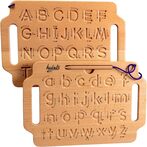 Trace the Pathway to Mastery with Wooden Alphabet Tracing Board. A double-sided marvel, this Montessori masterpiece allows young minds to glide through the ABCs with tactile grace. Every stroke nurtures a holistic bond between heart and intellect, anchoring ancestral wisdom in modern preschool education. Priced as a gift, yet valued as a treasure, to overlook this tool is to deny a cornerstone of empowering learning. Gift the gift of confident writing today. 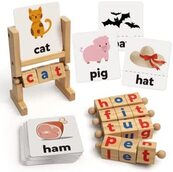 Journey Beyond Basic Alphabet with Coogam’s Wooden Reading Blocks. These short vowel rods transform spelling games into a magical rotation of discovery. With flash cards and rotating letters, they bridge the holistic worlds of sight words and preschool Montessori methods. More than a toy, it's an affordable key to literacy's kingdom. Let your child spin tales of knowledge and wonder today. 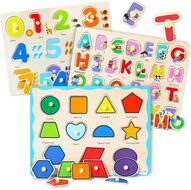 Go on a puzzle adventure with GRINNNIE's Wooden Peg Puzzle Set. Tailored for the eager minds of 3 to 5-year-olds, this 6-pack bursts with alphabets, numbers, shapes, animals, dinosaurs, and vehicles. A wholistic trove, it binds heart and intellect in a dance of discovery. This affordable preschool puzzle set isn't just a toy—it's a passport to a world where learning meets wonder. Let your child piece together their brilliant future today. 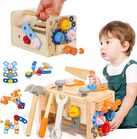 Craft Dreams with this STEM Wooden Tool Set. Designed for budding builders aged 2 to 5, this 38-piece ensemble is more than a toy—it's a hands-on journey through STEM. Merging Montessori principles with construction play, it molds heart, mind, and tiny hands into creators. An affordable bridge to the world of innovation, missing this toolkit means missing a chapter in a child's foundational tale. Empower your young innovator's journey today. 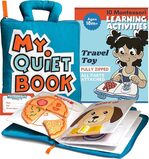 Whisper the wonders of learning with My Quiet Book. This Montessori-inspired felt masterpiece captivates toddlers aged 3-6 across its 10 enchanting pages. More than a travel toy, it's a silent symphony of educational exploration, touching both heart and intellect. As affordable as it is essential, bypassing this book is like muting a melody of discovery. Let your child's curiosity soar in hushed awe today. 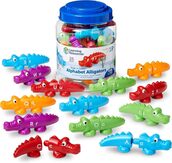 Snap into the joy of alphabets with the Snap-n-Learn Alphabet Alligators. Perfectly crafted for little hands 18 months and up, these double-sided, multicolored wonders make learning a delightful snap. Pairing fine motor skills with the enchantment of the alphabet, they're a bridge from heart to mind. In the world of affordable learning tools, missing these charming gators is to skip a splash of foundational fun. Let your little one chomp down on knowledge today. In homeschooling, we're like explorers with almost no limits on what we can learn about! Absolutely, academic success matters, but we shouldn't forget that looking after our kids wholistically is just as crucial. When we weave mind, body, and spirit into our homeschooling, something magical happens. It gives them a deep sense of being whole and capable, setting them on a path of self-discovery and mindfulness that will last their whole lives.
The Power of a Wholistic Homeschooling Approach Holistic homeschooling embraces the interconnectedness of mind, body, and spirit. By acknowledging and nurturing these aspects of our children's development, we lay the foundation for balanced growth, self-awareness, and resilience. Let's explore how we can integrate these elements into our homeschooling journey. Nurturing the Mind: Expanding Horizons Traditional education often emphasizes rote learning and standardized tests, but homeschooling opens the door to a wider learning range. Encourage your children to explore diverse subjects, rather than focusing solely on core subjects. Foster their curiosity and let them indulge in intellectual endeavors that ignite their passion. Empower your kids with critical thinking skills. Engage them in thought-provoking discussions and encourage them to question everything, including the status quo. A mind that questions is a mind that seeks truth and understanding. Strengthening the Body: A Temple of Power Incorporate physical activities into your homeschooling routine. Whether it's yoga, dancing, sports, or simply playing in the great outdoors, movement not only enhances physical health but also releases endorphins, promoting happiness and well-being. Teach your children the significance of nourishing their bodies with wholesome foods. Involve them in meal planning and preparation, creating a connection between the food they eat and its impact on their health. Also, be sure to include lessons on herbs and other natural healing to help prevent, as well as heal from many ailments. Nourishing the Spirit: A Journey Within Introduce mindfulness practices to your homeschooling curriculum. Meditation, breathing exercises, and moments of reflection allow kids to find stillness amidst the chaos and develop a deep connection with their inner selves. Foster an attitude of gratitude in your homeschooling environment. Encourage kids to express appreciation for the little things, teaching them that gratitude is a powerful tool for cultivating happiness. The Wholistic Homeschooling Curriculum: A Journey of Self-Discovery Incorporate mindful journaling into your homeschooling routine. Encourage your kids to pen down their thoughts, feelings, and reflections. Journaling is a magical gateway to self-discovery and personal growth. Embrace the power of creative expression. Art, music, and storytelling are potent ways for kids to externalize their emotions and connect with their inner worlds. Nature is a profound teacher. Plan regular nature walks, letting your kids immerse themselves in the wonders of the natural world. These moments of communion foster a deep connection with the environment and oneself. Turn mealtimes into mindful rituals. Teach your children to savor each bite, acknowledging the effort put into growing, preparing, and serving the food. Empowering Your Homeschooling Journey Show your children the importance of a balanced life by living it yourself. Embrace mindfulness, physical activity, and continuous learning, inspiring them to do the same. Foster your kids' independence by allowing them to take charge of their learning journey. Let them explore their interests and passions, guiding them along the way. Each child is a magical being with unique gifts and abilities. Celebrate their individuality and encourage them to express themselves authentically. Homeschooling is a magical journey of discovery. Embrace the joy of learning alongside your children, and let the enchantment of knowledge and growth unfold. In Conclusion: Empowerment Through Wholistic Homeschooling Unlock the power within your homeschooling experience by integrating mind, body, and spirit. Embrace the wholeness that comes from nurturing all three aspects of our being, and watch as your children blossom into mindful, confident, and empowered individuals. As we embark on this journey of wholistic education, let us remember that by empowering our children to control their own future, we are empowering them to embrace life's wonders and create a world of boundless possibilities. |
Heart 'N Mind Homeschool
Archives
June 2024
Categories
All
|
- Brand Shamans
- Brand Healing
- Inner Healing
-
INTENT-SIVE NATURE
- Content & Brand Elevation
- Healing Jewelry & Talismans
- Bath, Beauty, & Self-Care
- Healing Sessions
- Rituals, Herbs, & Altar Supplies
- Gawwwdess Baby Boutique
- Soul Flame Gifts
- Yoga & Meditation
- Books & Media
- Education & Homeschool Resources
- Home, RV, & Decor
- Clothing
- Pets
- Custom Orders
- Monthly Subscription Boxes
- October Festivals
- FLOW-Key Parenting
- About & Contact
- RV, Nature, & Travel Shamans
- Souls Within
- Life & Home
- Heart 'N Mind Homeschool
- The Homeschooling Mommy
- Books & Authors
- Speak Up!
- Pawsitive Pet Parenting
- Manifesterz
- Gifts In Minutes
- Brand Shamans
- Brand Healing
- Inner Healing
-
INTENT-SIVE NATURE
- Content & Brand Elevation
- Healing Jewelry & Talismans
- Bath, Beauty, & Self-Care
- Healing Sessions
- Rituals, Herbs, & Altar Supplies
- Gawwwdess Baby Boutique
- Soul Flame Gifts
- Yoga & Meditation
- Books & Media
- Education & Homeschool Resources
- Home, RV, & Decor
- Clothing
- Pets
- Custom Orders
- Monthly Subscription Boxes
- October Festivals
- FLOW-Key Parenting
- About & Contact
- RV, Nature, & Travel Shamans
- Souls Within
- Life & Home
- Heart 'N Mind Homeschool
- The Homeschooling Mommy
- Books & Authors
- Speak Up!
- Pawsitive Pet Parenting
- Manifesterz
- Gifts In Minutes






 RSS Feed
RSS Feed




